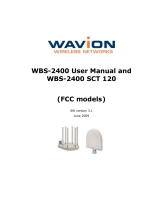
Contents
viii
MobileLAN access WA2X System Manual
Controlling Access to Access Point Menus......................................................................138
Enabling Access Methods ..................................................................................138
Setting Up Logins..............................................................................................140
Configuring the Access Point to Use a Password Server ........................141
Changing the Default Login .................................................................142
Creating a Secure Spanning Tree ....................................................................................143
Enabling Secure Communications Between Access Points and End Devices ...................145
Using an Access Control List (ACL) ..................................................................146
Configuring VLANs ..........................................................................................148
Configuring WEP 64/128/152 Security ............................................................150
Implementing an 802.1x Security Solution........................................................152
Configuring the Access Point as an Authenticator.................................153
Enabling Secure Communications Between Access Points ....................155
Configuring Wi-Fi Protected Access (WPA) Security ........................................158
Configuring WPA - PSK Security.........................................................160
Configuring WPA - 802.1x Security.....................................................161
Configuring the Embedded Authentication Server (EAS).............................. 163
About the Embedded Authentication Server (EAS).........................................................164
About Certificates...........................................................................................................164
Understanding Which Access Points Need Certificates......................................165
Understanding Which Certificates Are Installed by Default...............................165
Viewing the Certificates Installed on an Access Point.........................................166
Installing and Uninstalling Certificates ..............................................................166
Configuring the EAS ......................................................................................................168
Enabling the EAS ..............................................................................................168
Configuring the Database..................................................................................170
Using the Rejected List ......................................................................................172
Adding Entries to the Database.............................................................174
Clearing the Rejected List.....................................................................174
Exporting and Importing Databases ..................................................................174
Managing, Troubleshooting, and Upgrading Access Points........................ 177
Managing the Access Points............................................................................................178
Using the Wavelink Avalanche Client Management System...............................178
Configuring Your Access Points to Use Avalanche................................179
Managing Your Access Points Using Avalanche....................................180
Important Information When Using Avalanche....................................182
Using Simple Network Management Protocol (SNMP) ....................................182
Maintaining the Access Points ........................................................................................183
Viewing AP Connections...................................................................................183
Viewing AP Neighbors ......................................................................................186
Viewing Port Statistics.......................................................................................187
Viewing DHCP Status ......................................................................................188
Viewing the Events Log .....................................................................................189
7
8





















